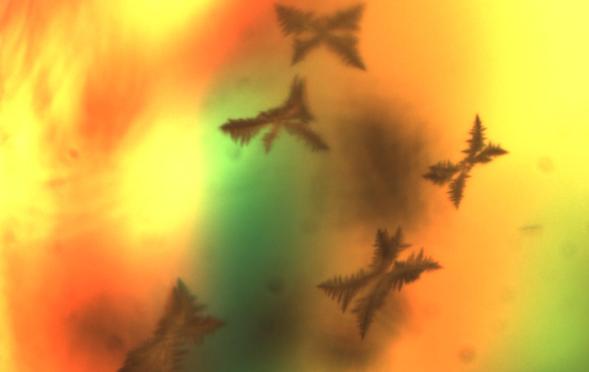Defect of the Month
Back to AGR's Library
This group of crystals resembles a cosmic traffic jam, but don’t bother looking for basketballs or NBA Superstars. Devitrification (i.e. recrystallization) of the glass melt typically occurs in areas of the furnace that are too cool. Usually, either wollastonite (CaSiO3) or diopside (CaMgSi2O6) crystals are formed depending on whether or not the glass composition contains magnesium; however, both types of stones were present in this piece of float glass. The diopside can be identified by concentric rings of pastel green and pink birefringence colors, while most of the wollastonite crystals display only a single color. Other optical properties, such as extinction angle, can provide more conclusive identification.

A deadly viper or a piece of lint fiber? To some, both possibilities in or on your glass container may be equally horrifying. This SEM image of a crinkled fiber viewed at 330x demonstrates the importance of experience in knowing what to look for. Contaminants such as weathering can adopt unusual geometries that can be confused with surface debris, and particles filtered from product can occur in almost any material or shape. We have even analyzed contaminants ranging from rodent dung, to machine oil, to blood.

Have you ever started a home-improvement project, but stopped because you ran out of materials? The defect in this picture is a little bit like a partially completed project and is referred to as an ‘unfilled finish.’ It occurs when the glass weight is too low and there isn’t enough glass left to fully form the finish. This type of defect prevents the bottle from being capped.

The picture was taken at 100x magnification in a polarizing microscope with a first order red insert. This is a stone that exhibits bright birefringence with crystals of zirconia at angles that are reminiscent of butterflies in flight. The stone is a melted viscous layer of a AZS refractory that dropped into the molten glass from above the flux line. Once surrounded by the molten glass it experienced comparatively cooler temperatures and the droplet recrystallized to form six sided crystals. The melting of AZS refractory that led to the stone creation had been caused by batch dusting and/or misdirected burners causing spikes in furnace temperature.
Pagination
- Previous page
- Page 11
- Next page